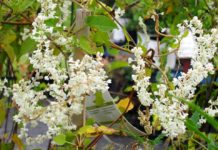Mention climbing plants and the name that springs to most people’s minds is Clematis an extremely varied genus numbering about 150 species of almost worldwide distribution. Most of the species are climbers, but some are high-fliers that will scale quite tall trees, others low scramblers. There is also herbaceous perennial clematis that makes freestanding border plants. Some species are deciduous others evergreen.
Although clematis is commonly associated with large, flat circular flowers, as in the ever-popular ‘Nellie Moser, some species in fact have quite small blooms that bells are stars. The color range runs through shades of blue, purple, red, yellow, and white.
Clematis scales their supports in an intriguing way. Whereas most climbers either twine or have tendrils or special sucker roots, the clematis hangs on by its foliage. Each leaf is composed of several leaflets, the long stalks of which rapidly encircle any likely support and thus act as tendrils. After the leaflets fall, the stalks thicken and become woody. Clematis will climb almost anything, but look especially fine in trees or tall shrubs.
How to Grow Clematis
Plant all clematis between autumn and late spring. Although lime is not essential, they thrive in neutral to alkaline soil of average fertility and with good drainage. Clematis resent root disturbance and should be planted out as pot-grown specimens. Put them in a position where stems and flowers are moist and shaded.
To help in the sun, but the roots are cool, to achieve this, the root area can be covered with stones or planted with low ground cover. Hence, support is needed for all climbing clematis, and the young shoots must be trained by tying them in. Moreover, propagate in spring by layering, or in summer by stem cuttings under glass. The species can also be increased from seeds in autumn.
Pruning is governed by three factors: plant vigour, flowering season, and available space. If necessary, strong growers, such as Clematis armandit and its forms, and C. montana, which should be pruned blooms on shoots made the previous year, should be pruned immediately after their single flowering period in late spring or early summer.
Where space is unlimited, the only pruning required is to thin out tangled shoots occasionally. If space is restricted, take out old and weak stems, and shorten other flowering shoots by up to two-thirds. If early summer-flowering the thin less vigorous growth to flowered hybrids ‘Lasurstern’ and ‘Nellie Moser’, which also flower on the previous year’s stems should be encouraged to branch from low down on the plant. Prune young plants back to 8-9 inches from ground level in early spring.
In subsequent years, thin out weak shoots and tie in replacement stems. After the second show of flowers in late summer, the shoots may be shortened by up to one-third if they are outgrowing the space available. Summer-to-autumn-flowering clematis (which includes C. viticella, C. x jackmanii and its forms, and large-flowered hybrids such as ‘Ernest Markham’, ‘Huldine’ and ‘Perle d’Azur’) flower on shoots of the current season. If they are left to scramble at will, the only pruning needed is to remove weak and old stems in spring; wall-trained plants should also be pruned in spring, by cutting shoots of the previous season back to a pair of strong buds.
Clematis armandii
The great plant collector Ernest Wilson (1876-1930) brought this lovely evergreen clematis to Britain from Western China in 1900. In the wild, like most other clematis it scrambles through trees, but in this country where it requires a sunny wall to ensure its success a good wire or net support must be provided in advance. This is because no established clematis can be retrained; indeed clematis armandii may cut off the flow of sap to any of its shoots that have been interfered with.
Young growth must be tied to support as soon as it appears. Once a framework is built up, curtains of dark green gleaming foliage will develop a perfect backcloth for the clusters of large, saucer-shaped creamy flowers in April and May. In the variety “Apple Blossom” the flowers are flushed with pink; in “Snow Drift” they are pure white.

Clematis (Large-Flowered Hybrids)
For magnificent effects in a wide range of colors, the Clematis (Large-Flowered Hybrids)are difficult to beat. The large-flowered is no misnomer. Most produce great starry blooms, 6 inches and more across, and most too in an off and on way, flower for several months on end. Each individual bloom has a long life due to its unusual structure of tough, colored sepal’s not tender petals.
There are many hybrids from which no choice, of which the bi-colored are among the most striking. Typical and very popular is “Nellie Moser” with pale pink, carmine-striped flowers that are at their best on a north-facing wall. Then there is Lasurstern, deep blue with lavender overtones and to take random and widely differing examples from among the splendid single-colored plants the pale blue ‘Mrs Cholmondeley’ ‘Perle d’Azur’ and the velvety-red ‘Ernest Markham’.







